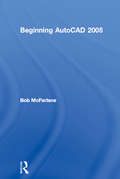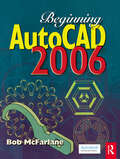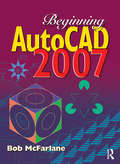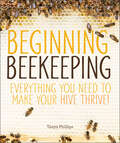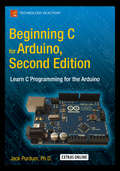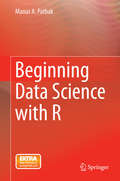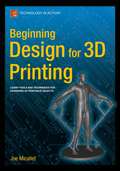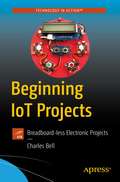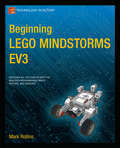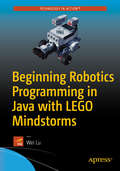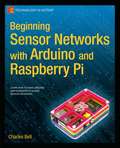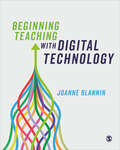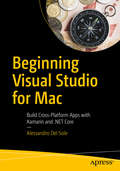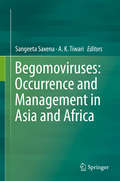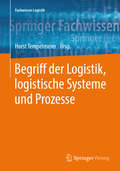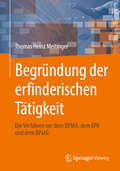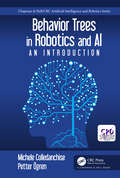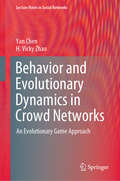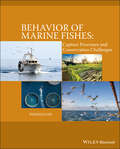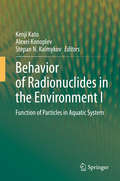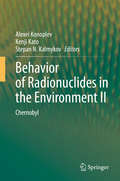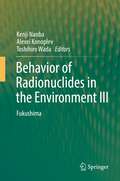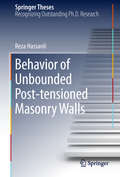- Table View
- List View
Beginning AutoCAD 2005
by Bob McFarlaneBeginning AutoCAD 2005 is a course based on learning and practising the essentials of 2D drawing using AutoCAD. Bob McFarlane’s hands-on approach is uniquely suited to independent learning and use on courses. The focus on 2D drawing in one book, ensures the reader gets a thorough grounding in the subject, with a greater depth of coverage than tends to be available from general introductions to AutoCAD. As a result, this book provides a true, step-by-step, detailed exploration of the AutoCAD functions required at each stage of producing a 2D drawing – an approach often not found in the many software reference guides available.The emphasis on learning through doing makes this book ideal for anyone involved in engineering, construction or architecture – where the focus is on productivity and practical skills. The author has also matched the coverage to the requirements of City and Guilds, Edexcel (BTEC) and SQA syllabuses.New features in AutoCAD 2005 are covered in this book including: Drafting Tools; Drawing Management; Drawing Output; Plot and Publish Tools; Productivity Tools; Sheet Set Manager, and Tool Palette Enhancements. The result is a useful refresher course for anyone using AutoCAD at this level, and those upgrading to the new software release. The course is also designed to be fully relevant to anyone using other recent releases, including AutoCAD 2004.Bob McFarlane is Curriculum Manager for CAD and New Media at Motherwell College, Scotland, and an Autodesk Educational Developer.
Beginning AutoCAD 2006
by Bob McFarlaneBeginning AutoCAD 2006 is a course based on learning and practising the essentials of 2D drawing using AutoCAD. Bob McFarlane’s hands-on approach is uniquely suited to independent learning and use on courses. The focus on 2D drawing in one book ensures the reader gets a thorough grounding in the subject, with a greater depth of coverage than tends to be available from general introductions to AutoCAD. As a result, this book provides a true, step-by-step, detailed exploration of the AutoCAD functions required at each stage of producing a 2D drawing – an approach often not found in the many software reference guides available.The emphasis on learning through doing makes this book ideal for anyone involved in engineering, construction or architecture – where the focus is on productivity and practical skills. The author has also matched the coverage to the requirements of City and Guilds, Edexcel (BTEC) and SQA syllabuses.New features in AutoCAD 2006 are covered in this book including: DYN (dynamic input showing coordinate position and lengths – an important new feature of the latest AutoCAD software), as well as new commands in the Modify and Dimension tool set. The result is a useful refresher course for anyone using AutoCAD at this level, and those upgrading to the new software release. The course is also designed to be fully relevant to anyone using other recent releases, including AutoCAD 2005.
Beginning AutoCAD 2007
by Bob McFarlaneBeginning AutoCAD 2007 is a course based on learning and practising the essentials of 2D drawing using AutoCAD. Bob McFarlane's hands-on approach is uniquely suited to independent learning and use on courses. The focus on 2D drawing in one book ensures the reader gets a thorough grounding in the subject, with a greater depth of coverage than tends to be available from general introductions to AutoCAD. As a result, this book provides a true, step-by-step, detailed exploration of the AutoCAD functions required at each stage of producing a 2D drawing - an approach often not found in the many software reference guides available.The emphasis on learning through doing makes this book ideal for anyone involved in engineering, construction or architecture - where the focus is on productivity and practical skills. The author has also matched the coverage to the requirements of City and Guilds, Edexcel (BTEC) and SQA syllabuses.The following new features in AutoCAD 2007 are covered in this book:* Create: Using enhanced commands and draughting tools to create all types of content* Manage: Using the Sheet Set Manager and Attribute Extraction to manage data and information* Produce: Using dynamic blocks, dynamic input and selection preview to increase productivity* Share: Using e-transmit, publish to the web and PDF files to share informationPlus, a new companion website features AutoCAD files for selected activities for students to work with.The result is a useful refresher course for anyone using AutoCAD at this level, and those upgrading to the new software release. The course is also designed to be fully relevant to anyone using other recent releases, including AutoCAD 2006.ABOUT THE AUTHOR Bob McFarlane has been writing books on AutoCAD for over 10 years.
Beginning Beekeeping: Everything You Need to Make Your Hive Thrive!
by Tanya PhillipsLearn everything you need to know to start your colony with this straightforward, highly visual guide for beginning beekeepers. Featuring more than 120 color photos, Beginning Beekeeping will teach any beginner how to foster and maintain healthy, vibrant colonies. You&’ll learn how to set up a colony and attract bees, how to incorporate best practices and techniques for keeping colonies strong, and how to troubleshoot and treat a broad range of common hive issues. Along the way, you&’ll learn how to harvest your honey and keep your bees healthy and happy. Included in Beginning Beekeeping: · Practical information on how a hive works, how and where to set up hives for maximum success, buying and installing bees, feeding bees, and more, with recommendations for both urban and rural settings · Effective treatment recommendations for dealing with common hive pests and diseases including mites, foulbrood, and colony collapse disorder (CCD), with recommendations for both conventional and organic treatments · Tips for dealing with common hive issues such as swarming, robbing, absconding, as well as guidance for managing aggressive hives and tips for keeping a queenright colony · Instructions for enjoying rich, bountiful honey harvests, and instructions for processing and storing the honey and wax from your hives, as well how to make products from your harvest · Seasonal guidance to ensure your hives return healthy and strong each and every year If you&’re new to beekeeping, Beginning Beekeeping is the perfect companion to get you started!
Beginning C for Arduino: Learn C Programming for the Arduino
by Jack PurdumBeginning C for Arduino, Second Edition is written for those who have no prior experience with microcontrollers or programming but would like to experiment and learn both. Updated with new projects and new boards, this book introduces you to the C programming language, reinforcing each programming structure with a simple demonstration of how you can use C to control the Arduino family of microcontrollers. Author Jack Purdum uses an engaging style to teach good programming techniques using examples that have been honed during his 25 years of university teaching. Beginning C for Arduino, Second Edition will teach you: The C programming language How to use C to control a microcontroller and related hardware How to extend C by creating your own libraries, including an introduction to object-oriented programming During the course of the book, you will learn the basics of programming, such as working with data types, making decisions, and writing control loops. You'll then progress onto some of the trickier aspects of C programming, such as using pointers effectively, working with the C preprocessor, and tackling file I/O. Each chapter ends with a series of exercises and review questions to test your knowledge and reinforce what you have learned. What you'll learn The syntax of the C programming language as defined for the Arduino Tried and true coding practices (applicable to any programming language) How to design, code, and debug programs that drive Arduino microcontrollers How to extend the functionality of C How to integrate low cost, off-the-shelf, hardware shields into your own projects Who this book is for The book is aimed at a complete novice with no programming background. It assumes no prior programming or hardware design experience and is written for creative and curious people who would like to blend a software and hardware learning experience into a single, enjoyable endeavor. Table of Contents Introduction to Arduino Microcontrollers Arduino C Data Types Decision Making in C Program Loops Functions in C Storage Classes and Scope Introduction to Pointers Using Pointers Effectively I/O Operations The C Preprocessor A Gentle Introduction to Object-Oriented Programming Arduino Libraries Arduino I/O Appendix A - Suppliers Appendix B - Hardware Components
Beginning Data Science with R
by Manas A. Pathak"We live in the age of data. In the last few years, the methodology of extracting insights from data or "data science" has emerged as a discipline in its own right. The R programming language has become one-stop solution for all types of data analysis. The growing popularity of R is due its statistical roots and a vast open source package library. The goal of "Beginning Data Science with R" is to introduce the readers to some of the useful data science techniques and their implementation with the R programming language. The book attempts to strike a balance between the how: specific processes and methodologies, and understanding the why: going over the intuition behind how a particular technique works, so that the reader can apply it to the problem at hand. This book will be useful for readers who are not familiar with statistics and the R programming language.
Beginning Design for 3D Printing
by Joe MicallefBeginning Design for 3D Printing is the full color go-to-guide for creating just about anything on a 3D printer. This book will demystify the design process for 3D printing, providing the proper workflows for those new to 3D printing, eager artists, seasoned engineers, 3D printing entrepreneurs, and first-time owners of 3D printers to ensure original ideas can be 3D printed. Beginning Design for 3D Printing explores a variety of 3D printing projects. Focus is on the use of freely available 3D design applications with step-by-step techniques that will demonstrate how to create a wide variety of 3D printable objects and illustrate the differences between splines, polygons, and solids. Users will get a deep understanding of a wide range modeling applications. They'll learn the differences between organic modeling tools, hard edge modeling, and precision, CAD-based techniques used to make 3D printable designs, practical products, and personalized works of art. Whether you are a student on a budget or a company exploring R & D options for 3D printing, Beginning Design for 3D Printing will provide the right tools and techniques to ensure 3D printing success. What you'll learn Learn the differences between the software modeling tools available for 3D printing. Understand the fundamental design concepts and definitions in the 3D modeler's toolkit. Learn the best tool for the project, and how to design 3D printable objects quickly and efficiently. Learn the differences between organic, hard edged, and precision based CAD techniques Avoid common design errors and mistakes that can lead to frustration. Ensure cost-efficient designs through optimization techniques. Create a range of objects from simple every-day designs to complex, articulated assemblies that are printable Gain an understanding of advanced procedures that exemplify how, in 3D printing, "design complexity is free". Who this book is for Beginning Design for 3D Printing is for anyone interested in essential 3D printing design techniques. This book is intended for artists, designers, engineers, students and entrepreneurs wanting to create their own original content for 3D printing. Table of Contents Chapter 1: What's Possible With 3D Printing? Chapter 2: Exploring Design Techniques for 3D Printing Chapter 3: Begin With a Box Chapter 4: Preparing the Box for 3D Printing Chapter 5: Creative Applications for Simple Shapes Chapter 6: Design Strategies for 3D Printing Chapter 7: Basic Solid Modeling Techniques Chapter 8: Organic Modeling Techniques Chapter 9: Customization Techniques Chapter 10: 3D Scanning Techniques Chapter 11: Intermediate Solid Modeling Techniques for Mechanical Connections Chapter 12: Advanced Techniques Using Blender Chapter 13: Working With 3D Printing Service Bureaus Appendix: Timeline of 3D Printing Design Milestones
Beginning IoT Projects: Breadboard-less Electronic Projects
by Charles BellExperiment with building IoT projects without the demanding time or patience required to learn about electronics. This book thoroughly introduces readers of all ages to the world of IoT devices and electronics without getting bogged down by the overly technical aspects or being tied to a specific platform. You'll learn IoT, Arduino, Raspberry Pi from the ground up using the Qwiic and Grove components systems. The book begins with a brief overview of IoT followed by primers for the two most popular platforms; Arduino and Raspberry Pi. There is also a short tutorial on programming each host; Arduino C-like sketches and Python scripts respectfully. Thus, the book also helps you get started with your choice of platform. Next, you’ll learn the basics for the Qwiic and Grove component systems.The rest of the book presents a number of projects organized into easy-to-follow chapters that details the goal for the project, the components used, a walk-through of the code, and a challenge section that provides suggestions on how to improve or augment the project. Projects are presented for both the Arduino and Raspberry Pi where possible making each project as versatile as possible.What You'll LearnWrite Arduino sketchesCreate Python scripts for the Raspberry PiBuild IoT projects with Arduino and Raspberry PiUse the Qwiic and Grove component systemsJoin the electronics and IoT hobby world with almost no experienceHost projects data in the cloud using ThingSpeakWho This Book Is ForThose interested in building or experimenting with IoT solutions but have little or no experience working with electronics. This includes those with little or no programming experience. A secondary target would include readers interested in teaching the basics of working with Arduino and Raspberry Pi to others.
Beginning LEGO MINDSTORMS EV3
by Mark RollinsBeginning LEGO MINDSTORMS EV3 shows you how to create new fun and fantastic creations with the new EV3 programmable brick along with other new EV3 pieces and features. You'll learn the language of the EV3 brick, and then go on to create a variety of programmable vehicles using MINDSTORMS and Technic parts. You'll then move into creating robot parts, including robotic arms. You'll even learn how to make different types of MINDSTORMS walkers. Finally, you'll learn how to incorporate light and sound into your amazing EV3 creations. Whether you're a MINDSTORMS enthusiast wanting to know more about EV3, a robotics competitor, or just a LEGO fan who wants to learn all about what EV3 can do, Beginning LEGO MINDSTORMS EV3 will give you the knowledge you need. Note: the printed book is in black and white. The Kindle and ebook versions are in color (black and white on black and white Kindles). What you'll learn How to program the new EV3 brick The different components new to the EV3 system How to program the EV3 with LabView How to build fantastic robotic creations How to incorporate Technic creations into MINDSTORMS Who this book is for MINDSTORMS and robotics enthusiasts who want to learn about EV3, and people who are completely new to MINDSTORMS and want a thorough and fun introduction. Table of Contents 1. Introduction to MINDSTORMS EV3 2. How to Program the EV3 Brick 3. Taking Control of a Vehicle with LEGO MINDSTORMS 4. Sound and Light 5. Data Logging and Advanced Programming 6. Special Construction Projects 7. The Robotic Arm 8. Creator and the Walking Robot
Beginning Robotics Programming in Java with LEGO Mindstorms
by Wei LuDiscover the difference between making a robot move and making a robot think. Using Mindstorms EV3 and LeJOS--an open source project for Java Mindstorms projects--you'll learn how to create Artificial Intelligence (AI) for your bot. Your robot will learn how to problem solve, how to plan, and how to communicate. Along the way, you'll learn about classical AI algorithms for teaching hardware how to think; algorithms that you can then apply to your own robotic inspirations. If you've ever wanted to learn about robotic intelligence in a practical, playful way, Beginning Robotics Programming in Java with LEGO Mindstorms is for you. What you'll learn: Build your first LEGO EV3 robot step-by-step Install LeJOS and its firmware on Lego EV3 Create and upload your first Java program into Lego EV3 Work with Java programming for motors Understand robotics behavior programming with sensors Review common AI algorithms, such as DFS, BFS, and Dijkstra's Algorithm Who this book is for: Students, teachers, and makers with basic Java programming experience who want to learn how to apply Artificial Intelligence to a practical robotic system.
Beginning Sensor Networks with Arduino and Raspberry Pi
by Charles BellBeginning Sensor Networks with Arduino and Raspberry Pi teaches you how to build sensor networks with Arduino, Raspberry Pi, and XBee radio modules, and even shows you how to turn your Raspberry Pi into a MySQL database server to store your sensor data! First you'll learn about the different types of sensors and sensor networks, including how to build a simple XBee network. Then you'll walk through building an Arduino-based temperature sensor and data collector, followed by building a Raspberry Pi-based sensor node. Next you'll learn different ways to store sensor data, including writing to an SD card, sending data to the cloud, and setting up a Raspberry Pi MySQL server to host your data. You even learn how to connect to and interact with a MySQL database server directly from an Arduino! Finally you'll learn how to put it all together by connecting your Arduino sensor node to your new Raspberry Pi database server. If you want to see how well Arduino and Raspberry Pi can get along, especially to create a sensor network, then Beginning Sensor Networks with Arduino and Raspberry Pi is just the book you need. What you'll learn How to build sensor nodes with both Arduino and Raspberry Pi! What is XBee? What methods you have for storing sensor data How you can host your data on the Raspberry Pi How to get started with the MySQL database connector for Arduino How to build database enabled sensor networks Who this book is for Electronics enthusiasts, Arduino and Raspberry Pi fans, and anyone who wants hands-on experience seeing how these two amazing platforms, Arduino and Raspberry Pi, can work together with MySQL. Table of Contents 1. Introduction to Sensor Networks 2. Tiny Talking Modules: An Intro to Xbee Wireless Modules 3. Arduino-Based Sensor Node 4. Rapberry Pi-based Sensor Notes 5. Where to Put It All: Storing Sensor Data 6. Turning Your Raspberry Pi into a Database Server 7. MySQL and Arduino: United at Last! 8. Building Your Network: Arduino Wireless Aggregator + Wireless Sensor Node + Raspberry Pi Server 9. Planning Wireless Sensor Networks 10. Shopping List
Beginning Teaching with Digital Technology
by Joanne BlanninTeachers are now expected to use technology to enhance students’ learning, but what does this mean in the classroom and how can you apply it effectively to subject teaching? This book, for pre-service and qualified teachers, offers you a guide for using technology in primary and secondary schools, including how to decide which technology resource to use, safeguarding and ethical considerations and computer coding in the classroom. Further guidance is provided on using technology across the learning areas of literacy, mathematics, STEM and the arts. Key features include: · Classroom scenarios which tackle common challenges faced by teachers and how to resolve them · Examples of best practice technology use in early childhood settings, primary and secondary classrooms · A future-proofed approach focusing on theory-informed best practice in an ever-changing world of devices and software Essential reading for pre-service teacher education students in both primary and secondary education courses on undergraduate and postgraduate routes into teaching and for qualified teachers looking to deepen their professional knowledge. Joanne Blannin is Senior Lecturer in Digital Transformations at Monash University.
Beginning Teaching with Digital Technology
by Joanne BlanninTeachers are now expected to use technology to enhance students’ learning, but what does this mean in the classroom and how can you apply it effectively to subject teaching? This book, for pre-service and qualified teachers, offers you a guide for using technology in primary and secondary schools, including how to decide which technology resource to use, safeguarding and ethical considerations and computer coding in the classroom. Further guidance is provided on using technology across the learning areas of literacy, mathematics, STEM and the arts. Key features include: · Classroom scenarios which tackle common challenges faced by teachers and how to resolve them · Examples of best practice technology use in early childhood settings, primary and secondary classrooms · A future-proofed approach focusing on theory-informed best practice in an ever-changing world of devices and software Essential reading for pre-service teacher education students in both primary and secondary education courses on undergraduate and postgraduate routes into teaching and for qualified teachers looking to deepen their professional knowledge. Joanne Blannin is Senior Lecturer in Digital Transformations at Monash University.
Beginning Visual Studio for Mac: Build Cross-Platform Apps with Xamarin and .NET Core
by Alessandro Del SoleQuickly learn how to get the most out of the Visual Studio for Mac integrated development environment (IDE). Microsoft has invested heavily to deliver their very best development tools and platforms to other operating systems. Visual Studio for Mac is a powerful developer tool that reinforces Microsoft's "mobile-first", "cloud-first", and "any developer, any platform, any device" strategy. With the author's guided expertise and extensive code samples, you will understand how to leverage the most useful tools in Visual Studio for Mac, the code editor, and the powerful debugger. You also will appreciate the author's guidance on collaborating with other team members using integrated tooling for the Git source control engine. Whether you are a Mac developer interested in cross-platform development or a Windows developer using a Mac, Beginning Visual Studio for Mac will quickly get you up to speed! What You'll Learn Prepare, configure, and debug in the Mac development environment Create cross-platform mobile apps for Android, iOS, and Windows with Xamarin and C# in Visual Studio for Mac Build cross-platform Web applications with . NET Core using Visual Studio for Mac Customize your productive and collaborative development environment Who This Book Is For Software developers using a Mac computer who want to build mobile or web applications that run on multiple operating systems
Begomoviruses: Occurrence and Management in Asia and Africa
by Sangeeta Saxena A. K. TiwariBegomoviruses are one of the most interesting plant viruses to study for basic and applied research as they cause huge economic losses to agriculture industries and farmers all over the world. They belong to family Geminiviridae and are emergent plant viral pathogens which cause diseases in various crops in the tropical and subtropical regions. They are transmitted by the whitefly (B. tabaci) and have either one (monopartite DNA-A) or two (bipartite DNA-A and DNA-B) genomic components. DNA-A and DNA-B are of ~2600 - 2800 nucleotides each. A number of serious diseases of cultivated crops of the Fabaceae, Malvaceae, Solanaceae and Cucurbitaceae families are caused by Begomoviruses which are considered as threat to their cultivation in many countries. Accurate diagnosis is important for successful diseases management, since plants infected by Begomovirus do not recover, suffer serious yield losses and act as further sources of inoculum, which is then picked up and spread by their vector whitefly (B. tabaci). Reports of occurrence of new viruses and re-emergence of several known viruses in new niches have become regular event. In such a dynamic system, growth of several crop species relies on an accurate diagnosis, management and better understanding of the biology of the casual virus. This is crucial to evolve appropriate control practices and to prevent the virus infection. Researchers have achieved considerable progress in characterization, detection and management of virus on different crop species in the last decade. This book covers latest information in diagnosis of begomoviruses in the present scenario and explores the new vistas in the field of genomics and proteomics. Chapters in Section 1 illustrates the occurrence, genome organisation, transmission and diagnostics of begomoviruses. It also details the diseases caused by begomoviruses on different crops, detection techniques and management strategies in support of research findings by presentation of data, graphics, figures and tables. Section 2 is a chapterwise collection of occurrence, diversity and status of begomoviruses in Asian Africa counties where the diseases are most prevalent. This book will provide wide opportunity to the readers to have complete information and status of begomovirus in Asia and Africa. This will be useful resource for researchers and extension workers involved in the begomvirus disease diagnosis and molecular biology. Expert detection, accurate diagnosis and timely management play a significant role in keeping plants free from pathogens. In this book expert researchers share their research knowledge and literature which are vital towards the diagnosis of begomoviruses, addressing traditional plant pathology techniques as well as advance d molecular diagnostic approach. The book deals with the economically important crops including fruits, vegetables along with challenges in crop protection against diseases caused by begomovirus. This will be resourceful and handy for researcher, practitioners and also students.
Begriff der Logistik, logistische Systeme und Prozesse (Fachwissen Logistik Ser.)
by Horst TempelmeierIn diesem Band wird in die begrifflichen Grundlagen der Logistik und des Supply Chain Managements eingeführt. Neben der Darstellung der Strukturen von logistischen Netzwerken und der darin ablaufenden Prozesse wird auf die wichtigsten Planungsprobleme eingegangen.
Begründung der erfinderischen Tätigkeit: Die Verfahren vor dem DPMA, dem EPA und dem BPatG
by Thomas Heinz MeitingerEin Patent kann für ein Unternehmen ein sehr wichtiges Asset sein. Der Weg dorthin ist jedoch steinig. Nur Erfindungen, die bislang noch nirgends zu finden sind und die außerdem eine erfinderische Leistung aufweisen, werden zum Patent erteilt. Die wichtigen Kriterien zur Patenterteilung sind daher Neuheit und erfinderische Tätigkeit. Die Begründung der erfinderischen Tätigkeit entscheidet regelmäßig in den Erteilungsverfahren vor den Patentämtern, dem Deutschen Patent- und Markenamt (DPMA) und dem Europäischen Patentamt (EPA), und bei streitigen Verfahren vor dem Bundespatentgericht (BPatG) über den Ausgang des Verfahrens. Dem Patentierungskriterium der erfinderischen Tätigkeit gebührt daher die größte Beachtung. Dieses Fachbuch gibt dem Leser das rechtliche Know-How, um in den jeweiligen Verfahren vor dem DPMA, dem EPA und dem BPatG erfolgreich die erfinderische Tätigkeit seiner Erfindung zu begründen bzw. in streitigen Verfahren einen erfolgreichen Angriff gegen ein Patent eines Dritten zu führen.
Behavior Trees in Robotics and AI: An Introduction (Chapman & Hall/CRC Artificial Intelligence and Robotics Series)
by Michele Colledanchise Petter ÖgrenBehavior Trees (BTs) provide a way to structure the behavior of an artificial agent such as a robot or a non-player character in a computer game. Traditional design methods, such as finite state machines, are known to produce brittle behaviors when complexity increases, making it very hard to add features without breaking existing functionality. BTs were created to address this very problem, and enables the creation of systems that are both modular and reactive. Behavior Trees in Robotics and AI: An Introduction provides a broad introduction as well as an in-depth exploration of the topic, and is the first comprehensive book on the use of BTs. <P><P> This book introduces the subject of BTs from simple topics, such as semantics and design principles, to complex topics, such as learning and task planning. For each topic, the authors provide a set of examples, ranging from simple illustrations to realistic complex behaviors, to enable the reader to successfully combine theory with practice. <P><P> Starting with an introduction to BTs, the book then describes how BTs relate to, and in many cases, generalize earlier switching structures, or control architectures. These ideas are then used as a foundation for a set of efficient and easy to use design principles. The book then presents a set of important extensions and provides a set of tools for formally analyzing these extensions using a state space formulation of BTs. <P><P> With the new analysis tools, the book then formalizes the descriptions of how BTs generalize earlier approaches and shows how BTs can be automatically generated using planning and learning. The final part of the book provides an extended set of tools to capture the behavior of Stochastic BTs, where the outcomes of actions are described by probabilities. These tools enable the computation of both success probabilities and time to completion. <P><P> This book targets a broad audience, including both students and professionals interested in modeling complex behaviors for robots, game characters, or other AI agents. Readers can choose at which depth and pace they want to learn the subject, depending on their needs and background.
Behavior and Evolutionary Dynamics in Crowd Networks: An Evolutionary Game Approach (Lecture Notes in Social Networks)
by Yan Chen H. Vicky ZhaoThis book offers a holistic framework to study behavior and evolutionary dynamics in large-scale, decentralized, and heterogeneous crowd networks. In the emerging crowd cyber-ecosystems, millions of deeply connected individuals, smart devices, government agencies, and enterprises actively interact with each other and influence each other’s decisions. It is crucial to understand such intelligent entities’ behaviors and to study their strategic interactions in order to provide important guidelines on the design of reliable networks capable of predicting and preventing detrimental events with negative impacts on our society and economy.This book reviews the fundamental methodologies to study user interactions and evolutionary dynamics in crowd networks and discusses recent advances in this emerging interdisciplinary research field. Using information diffusion over social networks as an example, it presents a thorough investigation of the impact of user behavior on the network evolution process and demonstrates how this can help improve network performance.Intended for graduate students and researchers from various disciplines, including but not limited to, data science, networking, signal processing, complex systems, and economics, the book encourages researchers in related research fields to explore the many untouched areas in this domain, and ultimately to design crowd networks with efficient, effective, and reliable services.
Behavior and Handling of Ships
by Henry H. HooyerA veteran tanker captain provides a comprehensive guide to the essential skills and dynamics involved in handling big ships.From working with scale model ships at the Shiphandling Training Center at Port Revel, France, to maneuvering oil tankers through the Port of Sidon in Lebanon, Captain Henry H. Hooyer has handled ships of all sizes through all kinds of situations. Now he shares his technical expertise in this detailed and authoritative manual. Captain Hooyer covers the various dynamics of ships moving through water, demonstrating how the forces acting on the ship will determine your approach to steering, speed, stopping, anchoring, and berthing. Chapters include The Peripatetic Pivot Point, Rudder and Propeller, Wind, Current, Narrow Channels, and more.
Behavior of Marine Fishes: Capture Processes and Conservation Challenges
by Pingguo HeUnderstanding fish behavior in relation to capture processes in marine fisheries is of fundamental importance to reducing bycatch and discards, and to enhancing marine fisheries conservation efforts. A thorough understanding of this allows commercial fishers to more effectively capture target species while reducing the catch of unwanted species. Behavior of Marine Fishes: Capture Processes and Conservation Challenges provides the reader with principles, patterns, and characteristics on fish behavior and fish capture processes using several types of important commercial fishing gears. The book also highlights conservation challenges facing the marine capture fisheries in efforts to maintain sustainable use of marine resources and to reduce negative impacts to the marine ecosystem. This volume, with contributions from leading applied fish behaviorists and fishing gear technologists from around the world, will be a valuable reference for researchers, fishing gear technologists, fisheries managers, students, and conservationists.
Behavior of Radionuclides in the Environment I: Function of Particles in Aquatic System
by Stepan N. Kalmykov Kenji Kato Alexei KonoplevThe 3-volume set highlights the behavior of radionuclides in the environment and focusing on the development of related fields of study, including microbiology and nanoscience. In this context, it discusses the behavior of radionuclides released in areas of Lake Karachai in Ural, and those released as a result of Chernobyl accident (1986), and in Fukushima (2011). Volume I presents the experiences gained in South Urals (“Mayak” plant, Lake Karachai), providing a scientific basis for more precise understanding of the behavior of radionuclides in complex subsurface environments. On the basis of monitoring data, it examines the pathways of radionuclide migration and the influence of the geological environment and groundwater on the migration, with a particular focus on particles from the nanoscale to microscale. It also discusses the function of microbes and microscale particles, from their direct interaction with radionuclides to their ecological role in changing the physic-chemical condition of a given environment. Lastly, the protective properties of geological media are also characterized, and mathematical modeling of contaminant migration in the area of Lake Karachai is used to provide information regarding the migration of radionuclides.
Behavior of Radionuclides in the Environment II: Chernobyl
by Stepan N. Kalmykov Kenji Kato Alexei KonoplevThis is Volume II in a three-volume set on the Behavior of Radionuclides in the Environment, focusing on Chernobyl. Now, so many years after the Chernobyl accident, new data is emerging and important new findings are being made. The book reviews major research achievements concerning the behavior of Chernobyl-derived radionuclides, including their air transport and resuspension, mobility and bioavailability in the soil-water environment, vertical and lateral migration in soils and sediments, soil-to-plant and soil-to-animal transfer, and water-to-aqueous biota transfer. The long-term dynamics of radionuclides in aquatic ecosystems are also discussed, in particular, the heavily contaminated cooling pond of the Chernobyl Nuclear Power Plant, which is in the process of being decommissioned. Lessons learned from long-term research on the environmental behavior of radionuclides can help us understand the pathways of environmental contamination, which, in turn, will allow us to improve methods for modeling and predicting the long-term effects of pollution. This book features a wealth of original data and findings, many of which have never been published before, or were not available internationally. The contributing authors are experts from Ukraine, Russia and Belarus with more than 30 years of experience investigating Chernobyl-derived radionuclides in the environment. The content presented here can help to predict the evolution of environmental contamination following a nuclear accident, and specifically the Fukushima Dai-ichi nuclear power plant accident.
Behavior of Radionuclides in the Environment III: Fukushima
by Alexei Konoplev Kenji Nanba Toshihiro WadaThis book, the third in the series Behavior of Radionuclides in the Environment, is dedicated to Fukushima. Major findings from research since 2011 are reviewed concerning the behavior of radionuclides released into the environment due to the Fukushima Dai-ichi Nuclear Power Plant accident, including atmospheric transport and fallout of radionuclides, their fate, and transport in the soil-water environment, behavior in freshwater, coastal and marine environment, transfer in the terrestrial and agricultural environment. Volume III discusses not only radionuclides dynamics in the environment in the short- and mid-term, but also modeling and prediction of long-term time changes.Along with reviews, the book contains original data and results not published previously. It was spearheaded by the authors from the Institute of Environmental Radioactivity at Fukushima University, established two years after the Fukushima accident, with their collaborators from Japan, Russia, and Ukraine. The knowledge emerging from the studies of the environmental behavior of Fukushima-derived radionuclides enables us to move forward in understanding mechanisms of environmental contamination and leads to better modeling and prediction of long-term pollution effects in general.
Behavior of Unbounded Post- tensioned Masonry Walls (Springer Theses)
by Reza HassanliThis book reports on a comprehensive analytical, experimental and numerical study on the flexural response of post-tensioned masonry walls under in-plane loads. It explores an important mechanism in this new generation of structural walls, called “Self-centering”. This mechanism can reduce residual drifts and structural damage during earthquake ground motion, and is particularly favorable for structures which are designed for immediate occupancy performance levels. The book reports on the development and verification of a finite element model of post-tensioned masonry walls. It describes a detailed parametric study to predict the strength of post-tensioned masonry walls. New design methodologies and expressions are developed to predict the flexural strength and force-displacement response of post-tensioned masonry. Experimental study is carried out to better understand the behavior of post-tensioned masonry walls and also to evaluate the accuracy of the proposed design procedure and expressions. The book also includes an introduction to current research on unbounded post-tensioned masonry walls, together with an extensive analysis of previously published test results.
